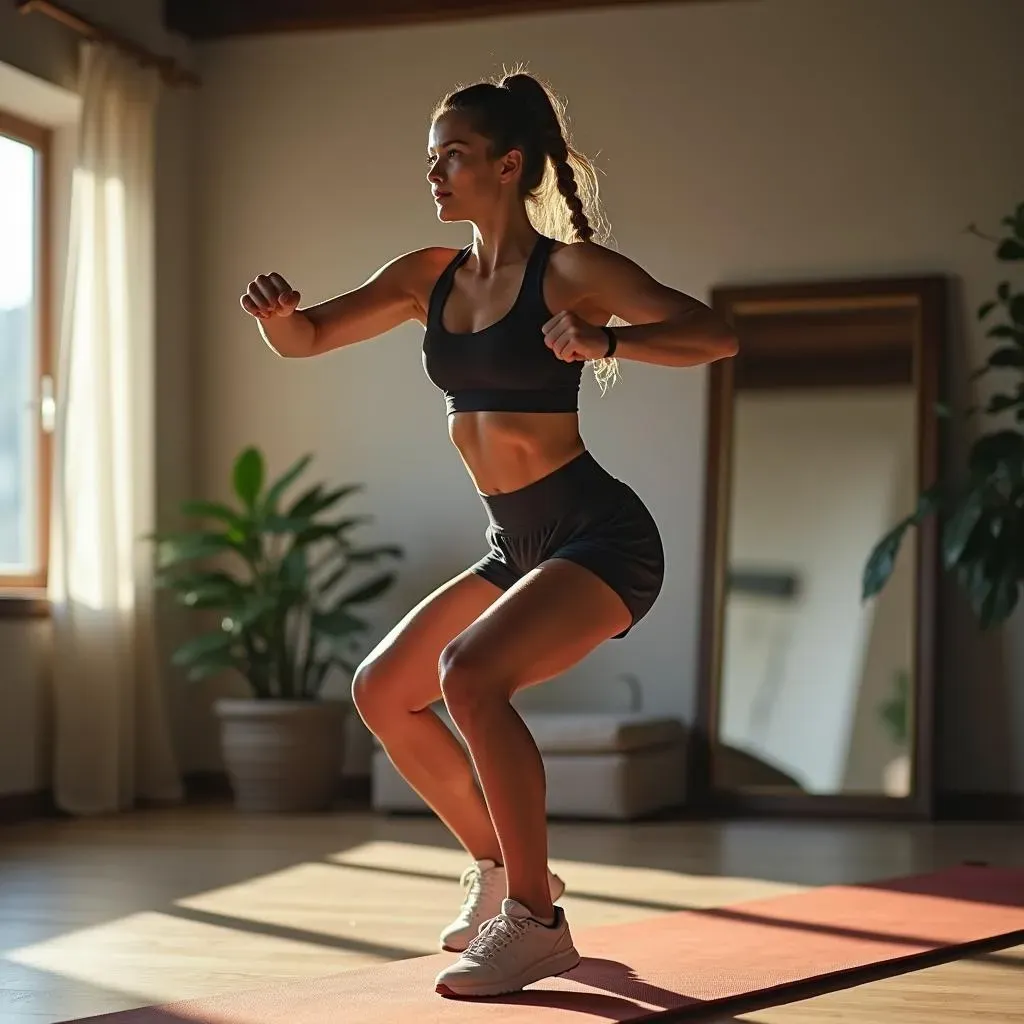Table of Contents
Ready to ditch the gym and sculpt a seriously awesome physique from the comfort of your living room? Then get ready to discover the power of cardio workouts at home with resistance bands! This isn't your grandma's aerobics class; we're talking intense, calorie-torching workouts that will challenge your muscles and elevate your heart rate, all without needing expensive equipment or a crowded gym. In this article, we'll break down everything you need to know to get started, from choosing the right resistance bands and mastering fundamental exercises to creating personalized workout routines that fit your fitness level and goals. We'll explore a variety of effective cardio exercises using resistance bands, showing you how to incorporate them into your home workout routine for maximum results. Whether you're a beginner or a seasoned fitness enthusiast, this guide will equip you with the knowledge and inspiration to transform your home into your personal fitness haven. Get ready to sweat, strengthen, and see amazing results with our comprehensive guide to cardio workouts at home with resistance bands.
Cardio Workouts at Home with Resistance Bands: Getting Started

Cardio Workouts at Home with Resistance Bands: Getting Started
Choosing Your Resistance Bands
So, you're ready to jump into the world of resistance band cardio? Awesome! First things first: let's talk bands. You've got a few choices here, and the best option depends on your current fitness level and goals. Think of resistance bands like gears on a bike – lighter bands are easier, great for beginners or warming up, while heavier bands provide a tougher challenge for more experienced folks. You can usually find sets with varying resistance levels, offering versatility for different exercises and muscle groups. Don't be afraid to experiment and find what feels right for you. Remember, it's all about progressive overload – gradually increasing the intensity over time to continue challenging your body.
Many brands offer excellent quality resistance bands. Look for bands made of durable, latex-free materials for a longer lifespan and to avoid any potential allergic reactions. Some bands even come with handles for a more comfortable grip, making certain exercises easier. Consider the length of the bands too; longer bands typically offer a greater range of motion, while shorter ones are better suited for specific exercises.
Band Type | Resistance Level | Best For |
|---|---|---|
Loop Bands | Light, Medium, Heavy | Legs, glutes, upper body |
Tube Bands with Handles | Light, Medium, Heavy | Full body, varied exercises |
Flat Resistance Bands | Light, Medium, Heavy | Stretching, warm-up, added resistance |
Setting Up Your Home Workout Space
Now that you've got your bands, let's talk about setting up your home gym. You don't need much space – a clear area about the size of a yoga mat will do. Make sure your space is well-lit and allows for free movement. A little bit of floor space is really all you need. A carpeted floor can be nice on the joints, but a smooth surface works too. Consider having a chair or sturdy object nearby for certain exercises that require an anchor point for your resistance bands. Lastly, and this is crucial – put on some tunes! Music can seriously boost your motivation and turn your workout into a fun and energizing experience. Trust me on this one; a great playlist can make all the difference.
Remember, safety first! Keep your workout area clear of clutter to prevent tripping or other accidents. Ensure good ventilation to prevent overheating. Having a water bottle within easy reach is also a must. And if you're new to resistance band training, start slowly. Listen to your body and don't push yourself too hard. Consistency is key! Even short, regular workouts will yield better results than sporadic intense sessions.
- Clear, spacious area
- Good lighting
- Anchor point (chair or sturdy object)
- Water bottle
- Upbeat music!
Effective Cardio Exercises Using Resistance Bands

Effective Cardio Exercises Using Resistance Bands
Resistance Band Jumping Jacks
Let's start with a classic, amped up! Resistance band jumping jacks aren't your average jumping jacks. Holding a band at chest height, with your hands shoulder-width apart, you'll add a powerful upper body component to the traditional move. As you jump your feet out to the sides, you'll pull the band apart, engaging your chest and shoulders. As you bring your feet back together, release the tension on the band. This is a fantastic full-body cardio blast that will get your heart rate soaring and work your upper and lower body simultaneously. Remember to keep your core tight throughout the entire movement to maximize your results and prevent injury. Aim for 3 sets of 15-20 repetitions.
The beauty of this exercise is its adaptability. You can adjust the intensity by using lighter or heavier resistance bands, or by speeding up or slowing down the tempo. If you're just starting out, try using a lighter band and focus on maintaining good form. As you get stronger, gradually increase the resistance to continue challenging your muscles. And remember, proper form is more important than speed. Focus on controlled movements to prevent injury and maximize results.
Set | Reps | Rest (seconds) |
|---|---|---|
1 | 15 | 30 |
2 | 20 | 30 |
3 | 15 | 60 |
High-Intensity Interval Training (HIIT) with Bands
Now, let's talk HIIT! HIIT workouts are short bursts of intense exercise followed by brief recovery periods. This method is super effective for burning calories and improving cardiovascular fitness. With resistance bands, you can create a HIIT workout that's both challenging and fun. Think about incorporating exercises like squat jumps with a band around your thighs, mountain climbers with a band around your ankles, and lateral walks with a band around your legs. Each exercise should be performed for 30-60 seconds, followed by a 15-30 second rest period. Complete 3-4 rounds of this circuit for a killer cardio workout.
The key to a successful HIIT workout is pushing yourself during the high-intensity intervals. Don't be afraid to break a sweat! The recovery periods are crucial for allowing your body to recover before the next round. Remember to listen to your body and adjust the intensity as needed. If you're new to HIIT, start with shorter intervals and fewer rounds. As you improve your fitness level, you can gradually increase the duration of the high-intensity intervals and the number of rounds. The beauty of HIIT is that you can easily customize it to fit your fitness level and available time. Even a 15-minute HIIT workout can be incredibly effective.
- Squat Jumps (band around thighs)
- Mountain Climbers (band around ankles)
- Lateral Walks (band around legs)
- Repeat 3-4 rounds
Designing Your Home Cardio Workout with Resistance Bands

Designing Your Home Cardio Workout with Resistance Bands
Creating a Balanced Routine
Okay, so you've got your bands and your space – now let's build a workout! The key is balance. You don't want to just hammer one muscle group; we're aiming for a full-body cardio experience. Think about incorporating exercises that target different muscle groups – upper body, lower body, and core. A good routine might include some jumping jacks (always a classic!), some lateral band walks for your legs and glutes, and maybe some overhead presses with the bands for your shoulders and arms. Remember to warm up before you start and cool down afterwards. A good warm-up might include some dynamic stretches, like arm circles and leg swings. Your cool-down should include some static stretches, holding each stretch for 20-30 seconds.
Start with a manageable number of exercises and repetitions. Don't try to do too much too soon. It’s better to start with a shorter workout and gradually increase the intensity and duration over time. Listen to your body and take rest days when needed. It's tempting to push yourself hard, but remember that rest and recovery are just as important as the workout itself. Consistency is key, so find a routine that you can stick with. Even short, regular workouts are more effective than intense, infrequent ones. Remember, progress is a marathon, not a sprint!
Exercise | Sets | Reps | Rest (seconds) |
|---|---|---|---|
Jumping Jacks | 3 | 20 | 30 |
Lateral Walks | 3 | 15 each side | 30 |
Overhead Press | 3 | 15 | 30 |
Incorporating HIIT and LISS
Now, let's spice things up a bit. To really maximize your cardio results, consider mixing up your routine with High-Intensity Interval Training (HIIT) and Low-Intensity Steady State (LISS) cardio. HIIT, as we discussed, involves short bursts of intense exercise followed by brief recovery periods. LISS is simply a longer period of moderate-intensity exercise. Mixing these two approaches keeps your body guessing and prevents plateaus. For example, you might start with a 10-minute LISS session of brisk walking or jogging with the resistance bands around your legs. Then, you could follow that up with a 15-minute HIIT workout incorporating some of the exercises we've mentioned earlier.
Remember to adjust the intensity and duration of your workouts based on your fitness level and goals. If you're a beginner, start with shorter workouts and fewer repetitions, gradually increasing the intensity and duration as you get fitter. Always listen to your body and take rest days when needed. Tracking your progress can be really motivating! Consider using a fitness tracker or a journal to monitor your workouts and see how far you've come. Celebrating small victories along the way keeps your spirits high and keeps you motivated. Remember, fitness is a journey, not a destination. Embrace the process and enjoy the ride!
- Warm-up (5 minutes)
- LISS (10 minutes)
- HIIT (15 minutes)
- Cool-down (5 minutes)
Progressing Your Workouts
The beauty of resistance band workouts is the ease of progression. As you get stronger, you can increase the intensity of your workouts in several ways. You can increase the resistance level of your bands, increase the number of sets and repetitions, decrease your rest periods, or add more challenging exercises. Another great way to progress is by focusing on proper form and technique. Mastering proper form allows you to fully engage the targeted muscles, leading to more effective workouts and reduced risk of injury. You can also increase the duration of your workouts as you feel more comfortable. Remember to listen to your body. If you're feeling overly sore or fatigued, take a rest day.
Don't be afraid to experiment with different exercise combinations and routines to find what works best for you. The key is to find a routine that you enjoy and that challenges you without causing injury. Remember, consistency is key. Even small, incremental improvements over time will lead to significant results. Celebrate your progress along the way and keep challenging yourself to reach new heights. And most importantly – have fun! Fitness should be enjoyable, not a chore. Find ways to make your workouts fun and engaging to help you stick with your routine.
Advanced Cardio Workouts at Home with Resistance Bands: Level Up Your Fitness

Advanced Cardio Workouts at Home with Resistance Bands: Level Up Your Fitness
Plyometrics and Power Moves
Ready to take your cardio to the next level? Let's dive into the world of plyometrics – explosive movements that build power and boost your cardiovascular fitness. Resistance bands are perfect for adding extra resistance to plyometric exercises, making them even more challenging and effective. Think jump squats with a band around your thighs, lateral bounds with a band around your ankles, or even box jumps with a band anchored to your waist. These exercises require more coordination and control, making them a fantastic way to challenge your body and build both strength and cardiovascular endurance. Remember to focus on proper form and control, prioritizing quality over quantity.
Start with a lower resistance band and fewer repetitions to ensure proper form. As you get stronger, gradually increase the resistance and the number of repetitions. Remember to listen to your body and take rest days when needed. Plyometrics are high-impact exercises, so it's important to listen to your body and not push yourself too hard, especially when starting out. Proper warm-up and cool-down are vital to prevent injuries. Include dynamic stretches like arm circles and leg swings before your workout, and static stretches like hamstring stretches and quad stretches after your workout.
Exercise | Sets | Reps | Rest (seconds) |
|---|---|---|---|
Jump Squats (band around thighs) | 3 | 10 | 45 |
Lateral Bounds (band around ankles) | 3 | 10 each leg | 45 |
Box Jumps (band around waist) | 3 | 8 | 60 |
Circuit Training with Increased Intensity
Circuit training is a fantastic way to maximize your cardio and strength gains in a short amount of time. It involves performing a series of exercises one after the other, with minimal rest between exercises. To elevate your circuit training with resistance bands, focus on incorporating more challenging exercises and reducing your rest periods. For example, you might include exercises like burpees with a band around your chest, mountain climbers with a band around your ankles, and rows with a band anchored to a sturdy object. Perform each exercise for 45-60 seconds, followed by only 15-20 seconds of rest. Repeat the circuit 3-4 times for a truly intense workout.
Remember, proper form is crucial in circuit training, especially when you're pushing yourself to work harder and faster. Focus on controlled movements to prevent injuries. As you get stronger, you can increase the intensity of your circuit training by adding more challenging exercises, decreasing your rest periods, or increasing the number of circuits. Listen to your body and adjust the intensity as needed. Remember that consistency is key. Even short, regular circuit training sessions are more effective than infrequent, intense workouts. The key is to find a routine that you enjoy and that challenges you without causing injury.
- Burpees (band around chest)
- Mountain Climbers (band around ankles)
- Rows (band anchored to object)
- Repeat circuit 3-4 times
Adding Advanced Variations and Progressions
Once you've mastered the basics, it's time to explore advanced variations and progressions. This could involve incorporating unilateral exercises (working one leg or arm at a time), using heavier resistance bands, or adding plyometric elements to your existing exercises. For example, you could try single-leg squats with a band around your thigh, single-arm rows with a band anchored to a sturdy object, or even jump lunges with a band around your ankles. These advanced variations challenge your balance, coordination, and strength, leading to significant improvements in both your cardio and strength.
Remember to focus on maintaining proper form and control throughout each exercise. As you progress, you may find yourself needing to adjust your workout routine to accommodate your increased strength and endurance. This could involve increasing the number of sets and repetitions, decreasing your rest periods, or adding more challenging exercises. But always prioritize proper form over speed or intensity. Listen to your body and take rest days when needed. Consider keeping a workout journal to track your progress and identify areas for improvement. Celebrate your achievements along the way and keep challenging yourself to reach new heights.
